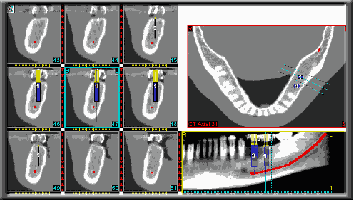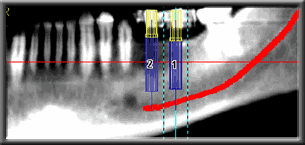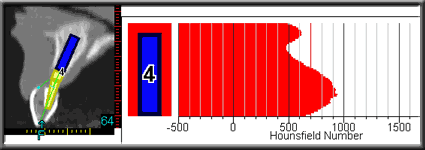When traditional dental x-rays do not provide sufficient information on the shape and amount of bone, a CAT scan is recommended. This digital information is then sent to Columbia Scientific, Inc., a company that reformats the data for dental use. Using a computer program called Sim/plant, we can view the jawbone from various angles. It becomes easy to determine the height, width, and density of the bone, and the location of the mandibular nerve and the maxillary sinus. Implant simulations can be done on the computer, so the exact size and ideal location for the implant is known.

Sim/plant overview showing the lower jaw from the front, top, and in cross-section slices. A 3-D view is also shown.

With Sim/plant, the height and width of the bone can be measured, and anatomical structures visualized. Here the mandibular nerve is identified and highlighted in red, and implant simulations are inserted to preview implant placement.

Closeup of side view of the lower jaw, with the mandibular nerve highlighted in red. Implant length and width simulation can determine final size needed.

Closeup of the occlusal view of lower jaw, showing natural teeth and simulation of 2 planned implants.

The cross-section view allows for determination of the implant width and length, and placement angle. Here, the proposed abutment is also shown.

The density of the bone can be seen, to evaluate if implants are feasible. The abutment post size and angle can be measured to help in planning for restorations (crowns).
For the majority of implants, clinical examination with x-rays is sufficient for treatment planning. However, for more complex cases, the Sim/plant provides precise information about jaw anatomy and warrants the extra expense.